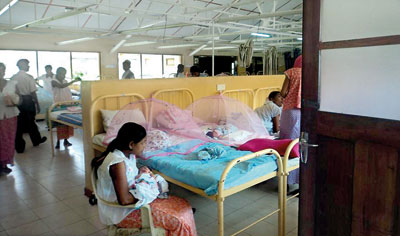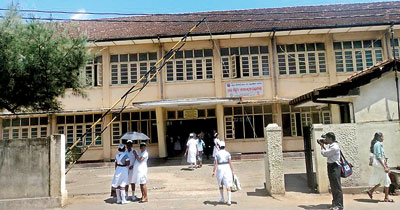New admissions have been halted and infection control procedures are being strictly enforced with the Neonatal Baby Unit undergoing a thorough clean-up at the Mahamodera Teaching Hospital in Galle following the death of twins, a high-level doctor has assured.
The swift action came in the wake of confirmation that of 12 deaths in the Baby Unit in February and early March, the pre-term twins succumbed to a bacterial infection, said Karapitiya Teaching Hospital Director Dr. Priyanee Senadheera who is overseeing Mahamodera Hospital since last week.
She stressed, however, that the other 10 deaths were due to prematurity, severe congenital issues in the babies or the babies being severely underweight. The twins had also been born about seven weeks before the due date, it is learnt.
 |
| The maternity ward at the hospital. Pix by G.D. Sugathapala |
 |
| The view of the Mahamodera Hospital from the main entrance |
While stringent infection-control steps are being taken, there are no new admissions to the unit, explained Consultant Neonatologist Dr. Kapilani Withanachchi, stressing that there was no need to shut down the unit.
At the time the Klebsiella infection which causes septicaemia was confirmed, there were 19 babies in the unit. Now two are on the ventilator and five are being kept in the unit due to feeding issues while the other babies are back with their mothers in the ward. Only the twins died of the infection though they were being treated with antibiotics, she pointed out, adding that pre-term and underweight babies such as the twins are very vulnerable as their immunity is low.
Reiterating that it is not easy to find beds in other Neonatal Units which are specialised in caring for newborns with complications -- a view echoed by doctors in other areas as well -- Dr. Withanachchi said they will be compelled to take in babies from the hospital’s labour room or theatre, if a dire emergency arises, while infection control procedures are on. “We simply cannot turn them away if there is no room elsewhere,” she said.
While Karapitiya Hospital has a Neonatal Intensive Care Unit, it does not have a maternal ward, the Sunday Times understands, as mothers and babies are handled by Mahamodera Hospital. Usually most Neonatal Units are working to capacity or even slightly above capacity, a Colombo-based source said.
Pointing out that there are 1,200 births per month at Mahamodera and that many expectant mothers with complications come there as it is a tertiary-care institution, Dr. Senadheera who is due to take over as Director of the Mahamodera Hospital said that as such the mortality (death) rate among newborns would usually be higher than at a normal hospital.
Referring to the deaths in February, Dr. Senadheera said while one twin died on February 29 and was confirmed as having succumbed to an infection, the other died on March 1 of the same cause.
But the other deaths were due to various problems of the babies themselves. Some died of severe congenital abnormalities; some were not very viable because they were very small (usually a newborn should be about 2.5 kilos, but in this case they were only about 500 gm); and others were premature, she said.
The Sunday Times learns that the Karapitiya Hospital microbiologist and her team who reviewed the situation had zeroed in on a multi-dose vial as the source of infection.
What usually happens is that the vial is opened and kept for the day with babies who require the injection during that day being administered the dose from the opened vial, Dr. Senadheera said, explaining that the organism did not come in the vial but the vial may have got contaminated after it was opened.
Other sources stressed that tertiary-care institutions are working against odds, amidst difficult conditions of a lack of equipment as well as a dearth of staff, to save critically-ill newborns. Even amidst such challenges, Sri Lanka has been able to keep the death rates of newborns down, one doctor explained.
There are three categories that need to be taken into account when considering these figures, the Sunday Times understands. Babies who fall between 28 weeks of gestation and one week after birth are in the ‘perinatal’ category; those who fall between birth and 28 days after birth are in the ‘neonatal’ category; and those who fall between birth and one year are in the ‘infant’ category.
Sri Lanka’s perinatal deaths which include stillbirths are around 17 per 1,000 births, while the neonatal death rate is 5.9 per 1,000 live births and the infant death rate 7.4 per 1,000 live births, says Consultant Community Physician Dr. Dhammika Rowel who is the National Programme Officer – Newborn Care at the Family Health Bureau, quoting the 2008 figures which are being used currently.
“This is comparable to figures in the developed world, even though there may be some drawbacks in the resources when compared to those countries,” she said.
Meanwhile, many health sources even in other areas were of the view that the Mahamodera matter had been blown out of proportion and a few people with certain agendas were attempting to cash-in on two tragic deaths.
A majority of the deaths in the last month were due to severe congenital abnormalities, prematurity or non-viability. “In such instances it is near-impossible to prevent the deaths,” a respected source said, while another added that Mahamodera was doing a good job even though there were many constraints including facilities, understaffing and dilapidated buildings.
Recently, a huge human resource problem at Mahamodera Hospital had been brought to the notice of the authorities, with the inability to give one-on-one care to babies who need such attention being reiterated, it is understood.
The answer is to provide the support and buildings they need, was the consensus.
Experts’ full report due tomorrow
The recommendations in the interim report of the expert-team of the Medical Research Institute, rushed to Maha Modera Hospital by the Health Ministry, as well as the Karapitiya Microbiologist have already been implemented, said Additional Secretary Dr. Palitha Mahipala.
The full report is due tomorrow, he told the Sunday Times, explaining that infection-control procedures which are carried out regularly have been further strengthened at Maha Modera.
The ministry is also providing all the support the hospital needs to overcome the situation, it is understood. |



